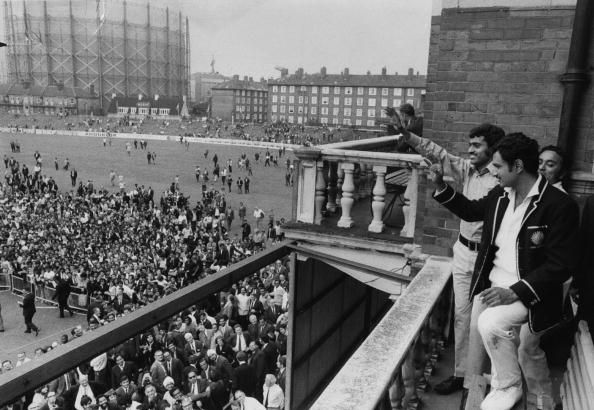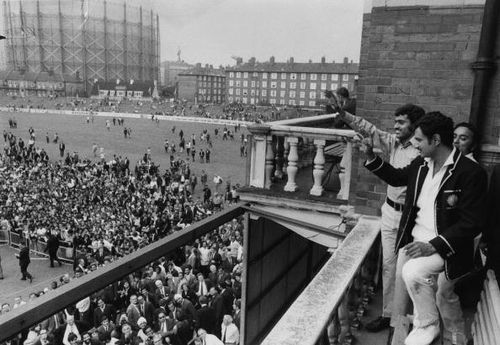
Indian cricket’s watershed moment in 1971

As India’s tour of England is underway, we look back at some of their memorable moments on English soil. This is a three-part article which will encompass their victorious tours of 1971, 1986 and 2007.
Prelude
The Indian team which arrived on England shores were quiet confident of performing well. They were fresh from a victorious tour of West Indies, where they won their first series on Caribbean soil. However, that particular West Indies team were in transition and led by the ageing legend Sir Garfield Sobers. And England were a much stronger side having regained the Ashes in a grueling 7-Test series in Australia. Added to all, there was the fickle English weather and sticky pitches.
A strong performance certainly required the batsmen to bat for long periods of time. In those days, it was a much longer tour. India played a whopping 8 practice matches before even the first Test began. They won 5 of those and lost only 1 match. All the batsmen looked in fine touch with the spinners getting into the groove as well.
Touring contingent
The famous Indian spin quartet of Bedi, Prasanna, Chandrasekhar and Venkataraghavan were at their peak then. The Indian team also had a rare commodity in a seam bowling all-rounder. Syed Abid Ali was entrusted by the captain Ajit Wadekar to have first use of the new ball. Another major talking point was the young Sunil Gavaskar who had burst on the scene with a record-breaking Test series in West Indies. He had a near perfect technique as an opener.
The squad also comprised of fine young batsmen in Gundappa Vishwanath and Ashok Mankad. Ashok’s father was the legendary all-rounder Vinoo Mankad who had been Indian cricket’s impact player for many years. Established wicket keeper-batsman Farokh Engineer was already a star with his dashing stroke-play and charming looks. He was extremely popular in Lancashire, whom he played for in English county cricket. Experienced batsmen like Dilip Sardesai and the skipper Ajit Wadekar himself were expected to shoulder the batting line-up. The presence of fine fielders in Eknath Solkar, Abbas Ali Baig and Venkataraghavan was a welcome change in the team which was usually labelled an ordinary fielding side.
The showpiece
The first Test began at the iconic Lord’s cricket ground. Ray Illingworth won the toss and opted to bat first. Abid Ali got the early wicket by sending Geoffrey Boycott back to the pavilion. Then, the spinners got into action. They left England reeling at 71/5. Some determined lower batting including a career-best innings by the tail ender John Snow took them to safety. The Indian reply was well constructed with the middle order taking them to a slender lead of 9 runs. Venkataraghavan ran through the tail in the second Innings and India were set a tricky target of 183. Gavaskar strung together a vital partnership with the promoted Engineer. Then, India stunningly collapsed to 145/8. With Bedi at the crease and only Chandrasekhar to follow, India considered themselves lucky as rain saved them from a nervy ending.
The second Test at Manchester began with Abid Ali scything through the English top order as England were tottering at 41/4. But they once again let it slip as a determined lower order century by the English captain rescued the hosts. India responded with half-centuries by Gavaskar and Solkar. But they could manage only 212. The England top-order made amends by thrashing an insipid Indian attack as they motored to set a target of 420. India were floundering at the end of day 4 having lost 3 wickets. Once again, rain intervened and helped the Indians.
With all to play for in the series decider at The Oval, Wadekar lost the toss for the third time. Some fine fielding and the guile of Bedi throttled England. A familiar trend emerged yet again as the lower-order played brilliantly for England and led them to 355. Alan Knott delighted the crowd with a stylish innings as he fell short of a hundred by just 10 runs.
The Indian riposte was a sedate one. They finally crawled their way to 284, thereby conceding a first innings lead of 71 runs. What was to follow was the most unexpected. Bhagwath Chandrasekhar produced the spell of his life-time as he demolished the England batting line-up. He was aided by some sensational fielding by the close in fields, most of all Eknath Solkar.
The catch to dismiss Alan Knott by Solkar off Venkataraghavan is forever etched in the history of cricket. A smart plan was worked out to get the better of Knott. They had seen him glance the spinners of his pads. The bait was set by having no leg slip and Venkataraghavan bowling over the wicket implored the batsman to take the chance. Solkar moved quickly, soared obliquely and pounced on the catch. This time, there would be no lower order rescue act for England as they could only manage to set India a target of 173. The middle order held firm as India cautiously crept to the target. India had created history by winning a Test series for the first time in England as they completed the 1-0 victory.
The Reverberation
The year of 1971 is now seen as the watershed moment of Indian cricket wherein they proved that they could not only compete, but also sustain the pressure to win Test series on foreign soil. The heroes returned to India amidst fervor as the realization that their team had turned over a new leaf dawned across the country. With no fast bowler to boot, India had stunned the top side in their own den. It was because of the immense pride in their performances and a collective team effort that Wadekar’s men wrote a new chapter in the history of Indian cricket.